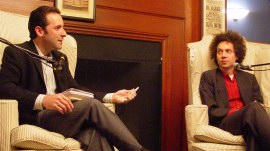danbricklin.com/log
|
||
|
|
Starting May 19, 2004
Harvard MBA class of 1979, MITX Fireside Chat with "Tipping Point" author Malcolm Gladwell, A new product from Software Garden
19May04-10Jun04
2004_05_19.htm
|
|
|
Harvard MBA class of 1979 [link]
Steve Syre of the Boston Globe published a column today about my class at the Harvard Business School (note: Boston Globe links go to the paid archives in just a couple of days...). Today is HBS graduation, and he looks back 25 years to get a taste of what could be to come. Our class produced "...a bumper crop of famous and occasionally infamous executives." He lists US Labor Secretary Elaine Chao, who left the corporate world to run the Peace Corps and later United Way of America, me, Clayton Christensen (Innovator's Dilemma), Meg Whitman (eBay), George McMillan (local firm CMGI), Jeff Skilling (Enron), John Thain (president of Goldman Sachs and now chief executive cleaning up the NYSE), Mary Cunningham (Bendix), Ron Sargent (Staples), Jim Bender (Aware), and Charlie Cuneo and Lisa Churchville (two local people). He didn't have room for many others, including my sectionmates John Lynch who is running for New Hampshire Governor, Chuck Bunch (PPG), and Charles Ward (Lazard). The list goes on and on.
Graduates of any school should know that having classmates that will make a big mark on the world is the norm. The challenge is to realize that you can be one of them if you keep at it.
Syre ends his column with a story I told him about our section that he uses to drive home the point that the "...recurring theme of their school years was a relentless sense of optimism." He writes: "Bricklin recalled one professor telling his class the story about a child happy to be mired in manure because, with all of the evidence around him, there had to be a pony somewhere nearby. Students embraced the glass-half-full message so completely that one rode a pony into the second-floor classroom on the final day of the course. The class of '79 grew to be people who reshaped their world mostly for the better. All of them started with some talent and the horse they rode in on."
From two of my sectionmates who were involved, here's a bit more detail about the pony story:
"[The subject]...was basically big picture [international] politics and economics...At the beginning of the semester the professor told the parable of the psychologist trying to determine whether personality was genetic or environmental...and so the child of the pessimistic parents was in a room full of toys, the child of the optimistic parents was in the room full of s*** as you say, and the kid in the s*** was grinning from ear to ear and the psychologist asks why and the kid says "With all this s***, there must be a pony in here somewhere!"...and the professor thought that was like the subject matter at hand..."
"This was the analogy the professor used for his subject--challenging us to stick with it and we'd find the pony...on the last day of class we did...We organized a local stable to bring a pony to campus...and offered them an extra $10 if the pony left a deposit in class [it didn't]...as we were leading the pony across campus, one of our other professors saw us out the window...he called administration and said "I think I see a horse going into Aldrich Hall"...whoever answered the phone said "sure..." and hung up on him...so we led the pony up two flights of stairs (very carefully)...on the landing I hopped on his back, led by two others, [while] another classmate stood up in class, dropped a bag of manure on the floor and shouted "we've found the pony" at which point the doors were opened and in we came...the class erupted."
MITX Fireside Chat with "Tipping Point" author Malcolm Gladwell [link]
Last night I attended yet another Fireside Chat. The organization that runs it is now known as MITX (Massachusetts Innovation & Technology Exchange) instead of MIMC (Massachusetts Interactive Media Council). The format and quality of the speakers remains the same.
The speaker was Malcolm Gladwell, best known as the author of the book "The Tipping Point". Since 1996 he has been a staff writer for The New Yorker magazine. As usual, the interviewer was journalist Scott Kirsner.
 Scott starts the questioning of Malcolm Gladwell
The questioning started by covering Malcolm's career, starting with his childhood. He said that his father told him one thing not to be: a journalist (not very lucrative). He tried getting a job in advertising (being rejected by 21 places) and, after all else failed, took a job with the American Spectator, a publication he knew nothing about at the time but that was willing to hire him. He eventually ended up at the Washington Post, and from there, like many others, ended up at The New Yorker.
Scott asked him: "What's a typical 'Malcolm Gladwell' article?" He said that he's interested in how systems work. He likes to write about "dumb obvious" things, like SUVs, malls, and ketchup. He says that anybody can make a good $300,000 car, it's making a good $12,000 one that's hard. The GAP is interesting, Oscar de la Renta is not. "The fringes are not interesting."
He talked about an upcoming article on ketchup. There are more fortunes lost on going after Heinz than in most anything else in food, he said. There is no gourmet high-end nor bargain low-end. In mustard there used to be just the brown and the yellow. Then Grey Poupon came in and sold a fraction as much mustard for three times the price. They had turned a commodity product into a high margin item. "Ah ha!" went the market. That's it, we'll broaden the lines of everything, so now we have lots of different types of tomato sauce, etc. But not ketchup. He has ideas why that's true. (Wait for the article. It has to do with the mechanics of taste.)
  Scott asked him to discuss his famous book, "The Tipping Point". He talked about the difference between the rides of William Dawes and Paul Revere. They both had the same idea, telling people the British were coming, but Dawes' ride produced no outpouring of volunteers while Revere's did. It seemed that the way the message was carried mattered, not just the idea itself. (Revere was a well-known citizen, Dawes was little known; and Revere knew who the influential people were to tell in each city, Dawes did not. As one person said, "Better Rolodex.") There are the concepts of "Mavens, Connectors, and Salesmen" in his book.
He then went on to talk about the fall of the Hummer SUV. In 2000-2001 every car company had to say they were working on something like it. Not now. Not all new ideas have strong roots in society to keep them going. He also talked about French Fries and the oil that makes them taste good, and why we switch to worse tasting oils for reasons that don't seem reasonable.
Scott then asked about technology, etc., including weblogs. Malcolm said that he reads several, including the New York-centric Gawker and one oriented to pharmaceutical houses. He sees blogs as a "wonderful form", but that we have to sort the information.
Technology, he says, raises questions it can't answer. He talked about cancer. Mammography gives us a type of breast cancer that can only be found on x-rays. Because we see them, we treat them, but it's unclear if that is cutting down the number of bad cases of breast cancer the little ones are supposed to be a precursor to. The diagnostic tools become the definition of the disease. Full body MRI of normal people he sees as a bad idea. Most cancers don't progress -- better to learn how to fix things after they progress.
He had a new book coming out. It's about when is there too much information. He compares rapid cognition (e.g., quick first impressions) to having lots of data. Patterns appear much more rapidly than we think.
Asked from the audience about where he gets his sources, he said the psychology literature, but mainly when someone told him. "If you mingle with interesting people long enough they'll tell you something interesting."
Asked about job interviews, he said that it's better to use darts. There are implicit prejudices in addition to the conscious ones. Those come out in body language, etc., and the interviewee responds and there is a feedback loop that affects the results. The situation doesn't measure most jobs. "Who you end up choosing is a function of how you choose."
Asked about reactions to his famous book, he talked about missing the issues that might lead to the suicide bombings in the Middle East, and the roles of an abundance of young males. He was too pessimistic about curbing smoking. He got the term "tipping point" from Thomas Schelling of Harvard.
He was asked by someone in the audience how to help move the web from silent to sound as a medium (not technically, but in acceptance of the idea). He talked about "reframing". He talked about how the broadcast in 1921 of the Dempsey-Carpentier fight reframed the view of radio. It changed from reporting of the news, just like a newspaper and other media, to bringing the event "into your living room". Atkins moved it from figuring out complicated fat content to easy carbohydrates. Seat belt usage was very low in the early 1980s. Then child restraint laws came in and usage jumped to the majority by 1986. Your strapped in kids asked why you weren't wearing them. It went from the government telling you to buckle up to your kids asking.
Finally, he says that the bias should be in editing information, and not in adding more information.
My take on his claim that less information is better? I think it has merit if understood in the context he presents it. As I see it, people are very bad appliers of weighting factors when evaluating lots of criteria. There ends up being a compression of ranges, and some items are given heavy weight because we have them (or because they were expensive to obtain) and others ignored because we don't have them. Using a simpler method for making decisions, based upon fewer factors that we know are relevant, may work better than having many for which we assign incorrect weightings. In those cases, less is better.
Here's a visual example. I've taken a picture of Scott and rendered it with just a simple brightness curve that just splits dark and light as well a complex curve that misapplies the dark and light but is generally correct. The simple curve works fine for identifying the picture while the complex one does not even though it takes into account more information.
   Original photo, simple curve that only makes every color either dark or light, complex curve that gives inappropriate factors to each brightness level
  The curves used in Photoshop to transform the pictures, "simple" and "complex"
A new product from Software Garden [link]
Finally, I've released the first new product from Software Garden since returning full-time. The product itself is very simple -- less than 400 lines of Perl plus documentation. The goal was not to make a major product. Rather, the goal was to do a complete release of a simple product, web site and all, to run on Windows, Mac, and Linux. (I wrote a bit about the choice of platform back in late February.) By keeping the product itself simple I could spend the time working on all the things around it. Now I have the web site style, build procedures, licensing terms, install instructions, etc., etc., finished to a "version 1" level, ready to be tested against the real world and then used with additional products.
As a product, I chose a simple program that I created for my own needs. I have several web sites (such as bricklin.com and satn.org) that run on a variety of web servers. I wanted to keep track of how they were performing and see how the hosting companies were doing their jobs. I had questions like: "Does the server go down at night? Is the inexpensive service as reliable as the expensive? Does my Internet connection go down for long periods when I'm not looking?" Years ago, Dave Winer ran a simple service on Weblogs.com that made a request to each listed web site every hour or so and tracked the response time. I liked how that gave me some indication of how my web site was doing. I wanted something like that for myself that I could control.
So, I've released Servertest 1.0. It lets you monitor how one or more web sites respond to requests for web pages over a long period of time, showing an indication of average response time and pattern of timeouts.
Servertest is written in the Perl computer language and can run on most computer systems, including Windows, Mac OS X, and Linux. What distinguishes it from many other products for monitoring servers is that it is available in source form for modification, enhancement, and redistribution (subject to a license). The program is straightforward, and lends itself to modification. Also distinguishing is that it is designed to follow a traditional Unix style with simple output and optional command line driven input yet work on a variety of operating systems. The output is formatted to make it easy to process with another program.
 Sample output from the Servertest program
In addition to the Perl source version, it is also available as a single executable for computers running Microsoft Windows that don't have Perl.
Subject to the terms of its license, it is free for noncommercial and educational use, and inexpensive otherwise, with a 30-day trial period. The license is a slightly modified version of the one I posted in my licensing essay.
For more information and to download see the Servertest section of the Software Garden web site.
|
||
|
© Copyright 1999-2018 by Daniel Bricklin
All Rights Reserved.
See disclaimer on home page.
|
||